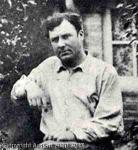Eugene Atget
Eugene Atget
장소: Libourne
타고난: 1857
죽음: 1927
전기:
Eugène Atget was a French flâneur and a pioneer of documentary photography, noted for his determination to document all of the architecture and street scenes of Paris before their disappearance to modernization. Most of his photographs were first published by Berenice Abbott after his death. An inspiration for the surrealists and other artists, his genius was only recognized by a handful of young artists in the last two years of his life, and he did not live to see the wide acclaim his work would eventually receive.
Jean-Eugène-Auguste Atget was born 12 February 1857 in Libourne. His father, carriage builder Jean-Eugène Atget, died in 1862, and his mother, Clara-Adeline Atget née Hourlier died shortly after. He was brought up by his maternal grandparents in Bordeaux and after finishing secondary education joined the merchant navy.
Atget moved to Paris in 1878. He failed the entrance exam for acting class but was admitted when he had a second try. Because he was drafted for military service he could attend class only part-time, and he was expelled from drama school.
Still living in Paris, he became an actor with a travelling group, performing in the Paris suburbs and the provinces. He met actress Valentine Delafosse Compagnon, who became his companion until her death. He gave up acting because of an infection of his vocal cords in 1887, moved to the provinces and took up painting without success. His first photographs, of Amiens and Beauvais, date from 1888.
In 1890, Atget moved back to Paris and became a professional photographer, supplying documents for artists: studies for painters, architects, and stage designers.
Starting in 1898, institutions such as the Musée Carnavalet and the Bibliothèque historique de la ville de Paris bought his photographs. The latter commissioned him ca. 1906 to systematically photograph old buildings in Paris. In 1899 he moved to Montparnasse.
While being a photographer Atget still also called himself an actor, giving lectures and readings.
During World War I Eugène Atget temporarily stored his archives in his basement for safekeeping and almost completely gave up photography. Valentine's son Léon was killed at the front.
In 1920–21, he sold thousands of his negatives to institutions. Financially independent, he took up photographing the parks of Versailles, Saint-Cloud and Sceaux and produced a series of photographs of prostitutes.
Berenice Abbott, while working with Man Ray, visited Atget in 1925, bought some of his photographs, and tried to interest other artists in his work. She continued to promote Atget through various articles, exhibitions and books, and sold her Atget collection to the Museum of Modern Art in 1968.
In 1926, Valentine died, and Man Ray published several of Atget's photographs in his La Révolution surréaliste.
Abbott took Atget's portrait in 1927. Eugène Atget died 4 August 1927 in Paris.
Atget took up photography in the late 1880s, around the time that photography was experiencing unprecedented expansion in both commercial and amateur fields. He sold photos of landscapes, flowers, and other pleasantries to other artists. It was not until 1897 that Atget started a project he would continue for the rest of his life—his Old Paris collection.
Atget photographed Paris with a large-format wooden bellows camera with a rapid rectilinear lens. The images were exposed and developed as 18x24cm glass dry plates.
Between 1897 and 1927, Atget captured the old Paris in his pictures. His photographs show the city in its various facets: narrow lanes and courtyards in the historic city center with its old buildings, of which some were soon to be demolished, magnificent palaces from before World War II, bridges and quays on the banks of the Seine, and shops with their window displays. He photographed stairwells and architectural details on the façades and took pictures of the interiors of apartments. His interest also extended to the environs of Paris.
In addition to architecture and the urban environment, he also photographed street-hawkers, small tradesmen, rag collectors and prostitutes, as well as fairs and popular amusements in the various districts. The outlying districts and peripheral areas, in which the poor and homeless sought shelter, also furnished him with pictorial subjects.
Distinguishing characteristics of Atget's photography include a wispy, drawn-out sense of light due to his long exposures, a fairly wide view that suggested space and ambiance more than surface detail, and an intentionally limited range of scenes avoiding the bustling modern Paris that was often around the corner from the nostalgia-steeped nooks he preferred. The emptiness of most of his streets and the sometimes blurred figures in those with people are partly due to his already antiquated technique, including extended exposure times which required that many of his images be made in the early morning hours before pedestrians and traffic appeared.
More...
Wikipedia link: Click Here














